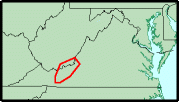EARTHQUAKES IN THE GILES COUNTY SEISMIC ZONE
 Since at least 1828, people in the Giles County seismic zone of southwestern
Virginia and adjacent West Virginia have felt small earthquakes and suffered
damage from infrequent larger ones. The largest damaging
earthquake (magnitude 5.9) in the seismic zone occurred in 1897. Smaller,
slightly damaging earthquakes occur at variable intervals, but in the zone
they tend to occur a few decades apart. Still smaller earthquakes that cause
no damage are felt once or twice a decade in the seismic zone.
Since at least 1828, people in the Giles County seismic zone of southwestern
Virginia and adjacent West Virginia have felt small earthquakes and suffered
damage from infrequent larger ones. The largest damaging
earthquake (magnitude 5.9) in the seismic zone occurred in 1897. Smaller,
slightly damaging earthquakes occur at variable intervals, but in the zone
they tend to occur a few decades apart. Still smaller earthquakes that cause
no damage are felt once or twice a decade in the seismic zone.
Earthquakes in the central and eastern U.S., although less frequent than in the western U.S., are typically felt over a much broader region. East of the Rockies, an earthquake can be felt over an area as much as ten times larger than a similar magnitude earthquake on the west coast. A magnitude 4.0 eastern U.S. earthquake typically can be felt at many places as far as 100 km (60 mi) from where it occurred, and it infrequently causes damage near its source. A magnitude 5.5 eastern U.S. earthquake usually can be felt as far as 500 km (300 mi) from where it occurred, and sometimes causes damage as far away as 40 km (25 mi).
FAULTS
Earthquakes everywhere occur on faults within bedrock, usually miles deep.
Most bedrock beneath southwestern Virginia and adjacent West Virginia was
assembled as continents collided to form a supercontinent about 500-300
million years ago, raising the Appalachian Mountains.
At well-studied plate boundaries like the San Andreas fault system in California, often scientists can determine the name of the specific fault that is responsible for an earthquake. In contrast, east of the Rocky Mountains this is rarely the case. The Giles County seismic zone is far from the nearest plate boundaries, which are in the center of the Atlantic Ocean and in the Caribbean Sea. The seismic zone is laced with known faults but numerous smaller or deeply buried faults remain undetected. Even the known faults are poorly located at earthquake depths. Accordingly, few, if any, earthquakes in the seismic zone can be linked to named faults. It is difficult to determine if a known fault is still active and could slip and cause an earthquake. As in most other areas east of the Rockies, the best guide to earthquake hazards in the seismic zone is the earthquakes themselves.
Source: NEIC/USGS